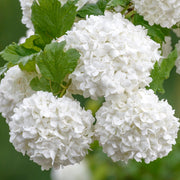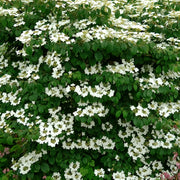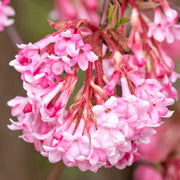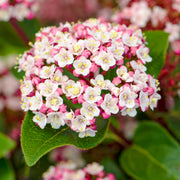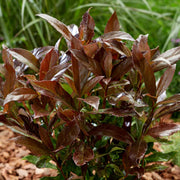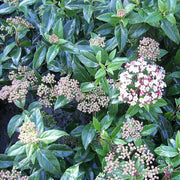Product description
Viburnum 'Kilimanjaro Sunrise' (also known as Japanese Snowball) is a compact low-growing shrub with deciduous foliage, with dark-green and deeply veined leaves, that darken into a rich orange/red icolour during autumn. The lace-cap flowers of this plant initially bloom completely white during spring time, before gaining an apple blossom pink later in summer, flowers are followed by berries with a deep-red colour that becomes fully black in autumn.
This variety enjoys either full sun or partial shade, it is suited to any type of soil provided it has good drainage. Please be aware that the berries grown from this plant are not for human consumption.
Please Note: Images are for illustrative purposes only and designed to be a representation of the item(s) being sold. Depending on seasonality, deciduous plants may be supplied in their dormant state and without leaves. Plants may also be pruned back, lower than stated heights, to encourage new growth.
Garden Plant Size Guide

Plants in larger pots can be multiple years older than their smaller counterparts with more mature root systems and foliage. This makes them able to thrive as a full size plant in your garden quicker than smaller alternatives.
The most common size of pot that garden plants come in are 9cm/1L/3L/5L this is in reference to the diameter at the top of the pot.
9cm potted plants still remain the most popular cost effective option though, they just may take a little patience to allow them to grow into full maturity once planted in your garden.
Plant specs, care guide & tips
Key features
Specifications
When to plant
| Jan | Feb | Mar | Apr | May | Jun | Jul | Aug | Sep | Oct | Nov | Dec |
|---|---|---|---|---|---|---|---|---|---|---|---|
Planting and period of interest times are general guidelines and may vary based on your location and conditions. For best results, consult local gardening resources.
Instructions
Top Tip
Prune viburnum after flowering to maintain shape and encourage new growth. Remove dead or damaged branches to promote better air circulation and a healthier plant.
How to Water
Water viburnum deeply and regularly during the first growing season to establish roots. Once established, they’re drought-tolerant but benefit from occasional watering during dry spells. Avoid overwatering to prevent root rot.
How to Plant
Choose a sunny or partially shaded spot with well-draining, fertile soil. Dig a hole twice as wide and the same depth as the root ball. Place the plant, backfill with soil, and firm gently. Water thoroughly after planting and mulch to retain moisture. Space plants 120-180cm apart.






